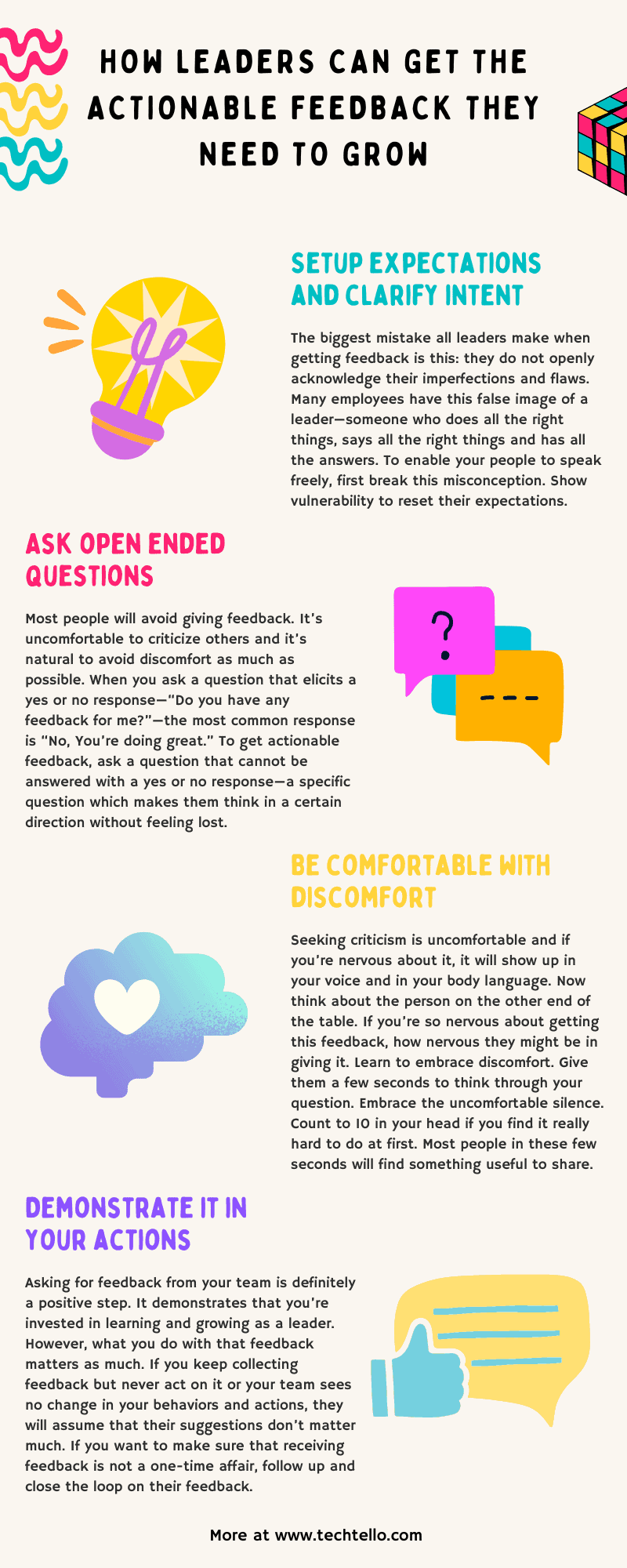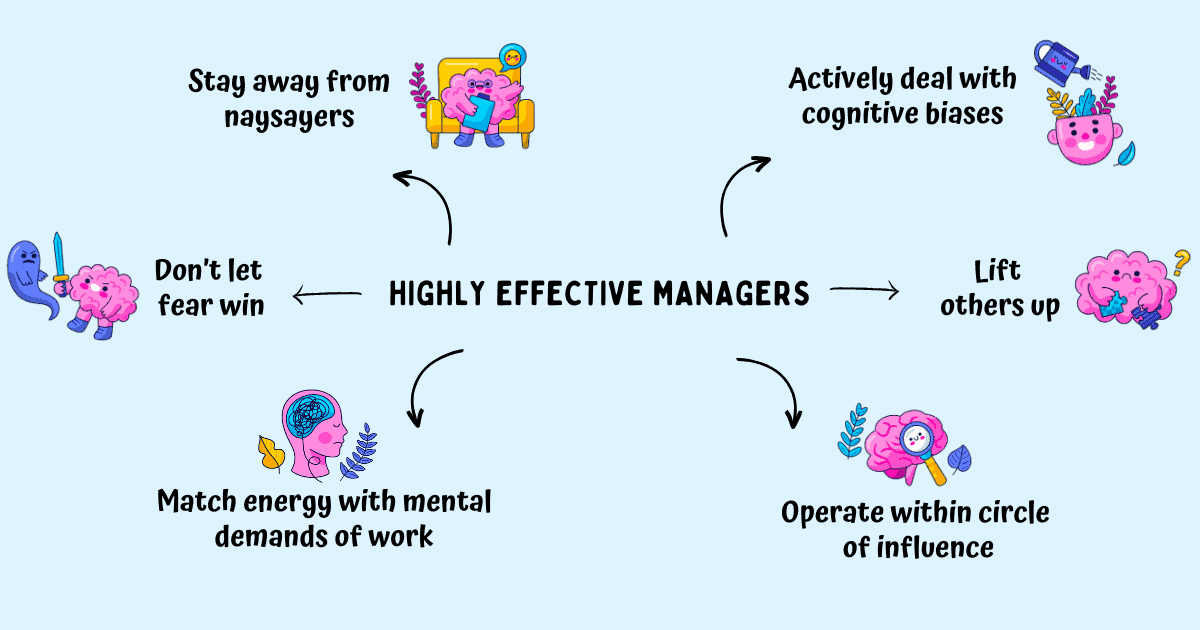How Leaders Can Get the Actionable Feedback They Need to Grow

Feedback is a crucial part of growth. If you don’t know how you’re doing, it’s impossible to take corrective actions and improve.
Many leaders fail at this. They either do not explicitly seek feedback or the way they ask for it only boosts their ego by getting feel-good praise about what they’re doing well without surfacing the actual areas where they’re falling short.
There are lurking gaps in how leaders view their actions and how others perceive them leading to inadvertent blind spots. Without getting the criticism they need, they keep repeating the same mistakes over and over again. Not taking the time to reconcile reality perpetuates disconnect and dissonance.
As a leader, making your employees comfortable to criticize you isn’t easy. Don’t expect them to walk over to you and give you the feedback unless you take the first few steps in seeking it.
Done right, feedback can be a great tool to get rid of behaviors that are damaging to yourself and the success of your organization and its people.
The real leverage is creating pull. Creating pull is about mastering the skills required to drive our own learning; it’s about how to recognize and manage our resistance, how to engage in feedback conversations with confidence and curiosity, and even when the feedback seems wrong, how to find insight that might help us grow.
— Douglas Stone, Thanks for the Feedback
To get clear and actionable feedback, follow these practices:
Setup expectations and clarify intent
The biggest mistake all leaders make when getting feedback is this: they do not openly acknowledge their imperfections and flaws.
Many employees have this false image of a leader—someone who does all the right things, says all the right things and has all the answers. This makes it hard for them to digest that leaders aren’t perfect—they also have room for improvement just like others.
People aren’t able to muster up the courage to speak the truth because of this cognitive dissonance—their mind portrays the perfect image of the leader which conflicts with their experience.
To enable your people to speak freely, first break this misconception. To do this:
- Whenever you make a mistake, acknowledge it openly.
- When you don’t know something, don’t pretend. Show curiosity to understand.
- Don’t hold feedback. Give it as you see it.
Showing vulnerability resets their expectations. Now when you ask for feedback, they won’t be taken aback. They won’t be surprised and shocked at the same time that you as a leader need their feedback.
But sometimes, setting expectations isn’t enough. They need to hear you say it. Stating your intent before asking for feedback is a powerful way to encourage them to say things as you need to hear them.
Start like this: Even with the best intentions at heart, I don’t always make the right decisions, do the right thing or act in a way that’s in the best interest of my organization and its people. I understand and acknowledge it. But I also know that with the right feedback, I can do better. I am hoping you’ll help me on this journey with transparency and honesty.
Ask open ended questions
You got started on the right note, but that does not guarantee you’ll get the feedback you need. How you frame the question also determines what response you get.
Most people will avoid giving feedback. It’s uncomfortable to criticize others and it’s natural to avoid discomfort as much as possible.
When you ask a question that elicits a yes or no response—“Do you have any feedback for me?”—the most common response is “No, You’re doing great.”
It’s also hard to answer such questions. They may not know where to start or what to say. Instead of keeping quiet, it feels safer to say no.
To get actionable feedback, ask a question that cannot be answered with a yes or no response—a specific question which makes them think in a certain direction without feeling lost. For example:
- What one thing can I do to communicate better?
- What one thing should I stop doing in meetings to make them more effective?
- What one thing can I do to be more supportive?
- What one thing can I do to encourage more ideas from the team?
- What one thing should I stop doing that impacts your productivity?
Open-ended questions like these are a great way to prompt them to think. They get a chance to express their thoughts and concerns, which makes them feel valued and supported. You get an opportunity to take corrective action. A true win-win.
To seek truth requires one to ask the right questions. Those void of truth never ask about anything because their ego and arrogance prevent them from doing so. Therefore, they will always remain ignorant. Those on the right path to Truth are extremely heart-driven and childlike in their quest, always asking questions, always wanting to understand and know everything — and are not afraid to admit they don’t know something. However, every truth seeker does need to breakdown their ego first to see Truth. If the mind is in the way, the heart won’t see anything.
— Suzy Kassem, Rise Up and Salute the Sun
Be comfortable with discomfort
Seeking criticism is uncomfortable and if you’re nervous about it, it will show up in your voice and in your body language.
Now think about the person on the other end of the table. If you’re so nervous about getting this feedback, how nervous they might be in giving it.
Learn to embrace discomfort. Be calm and composed to make the feedback giver feel at ease too. And don’t forget this most important thing: once you ask the question, don’t fill silence with words. It’s tempting to keep speaking assuming it will make the conversation easier, but the more words you stuff into the question, the harder it gets to comprehend and respond back.
Give them a few seconds to think through your question. Embrace the uncomfortable silence. Count to 10 in your head if you find it really hard to do at first. Most people in these few seconds will find something useful to share. Others may need more time. Don’t pressurize them to respond instantly. Request them to think through your question and share inputs later.
Here’s what you can say: I might have put you on the spot with this question. I understand if you need more time to give me feedback. I’ll appreciate it if you can think through this question and help me with useful inputs next time. I am trying to do better as a leader and every feedback counts.
Silence is only frightening to people who are compulsively verbalizing.
— William S. Burroughs, The Job
To become comfortable with discomfort, follow these practices:
- Step out of your comfort zone regularly. Challenge yourself to engage in activities that are hard to do at first.
- Explore new experiences than you’re used to.
- Challenge the status quo and take calculated risks.
- Be ok with the awkwardness when you try something new.
- Embrace the emotions you feel when doing something difficult and reframe them in a positive light.
Continuously stepping out of your comfort zone will make such conversations easier. When your mind and body is tuned to consider discomfort as an essential part of growth, seeking criticism won’t feel so unnatural.
Demonstrate it in your actions
Asking for feedback from your team is definitely a positive step. It demonstrates that you’re invested in learning and growing as a leader.
However, what you do with that feedback matters as much. If you keep collecting feedback but never act on it or your team sees no change in your behaviors and actions, they will assume that their suggestions don’t matter much.
They’ll stop sharing feedback proactively and even when you ask for it, they won’t see a point in sharing it. If you want to make sure that receiving feedback is not a one-time affair, follow up and close the loop on their feedback.
To do this:
- Tell them what you plan to do with their suggestions or concerns.
- When you act on their feedback, share your progress irrespective of the outcome.
- If the feedback involved changing your behavior, keep seeking feedback on how you’re doing—are you staying the same, getting worse or making progress and becoming better?
- If their suggestion or concern can’t be addressed, don’t go mum. Setup the right expectations and clarify why you chose to keep it this way.
Habit changes don’t happen overnight. However, holding yourself accountable to put in the effort and seeking continuous feedback can help you stay on track.
The only thing worse than not requesting feedback is not acting on it.
— Frank Sonnenberg, Listen to Your Conscience
Legendary coach Vince Lombardi once said, “Leaders aren’t born, they are made.” Leaders who bury their heads in the sand by avoiding difficult feedback stay ignorant of the harmful effects their behaviors and actions have on people. Those who embrace it take their teams to great heights.
If you’re a leader, ignoring your ignorance is not an option. Be courageous. Face your fears. Get the feedback you need.
Summary
- Getting actionable feedback from your employees is important to lead. The only way to know what your employees feel about you is to go and ask for it.
- Getting honest feedback is difficult as a leader. Unless you explicitly ask for it, you’re most likely going to get none.
- Don’t create the faulty image of a perfect leader without flaws. Set real expectations that you are learning and growing much like everyone else.
- Frame your questions in a way that makes it easy for the feedback giver to share useful inputs.
- Practice stepping out of your comfort zone regularly. It will make your feedback conversations less scary.
- Most importantly, don’t seek feedback if you’re not willing to put it into action.






























